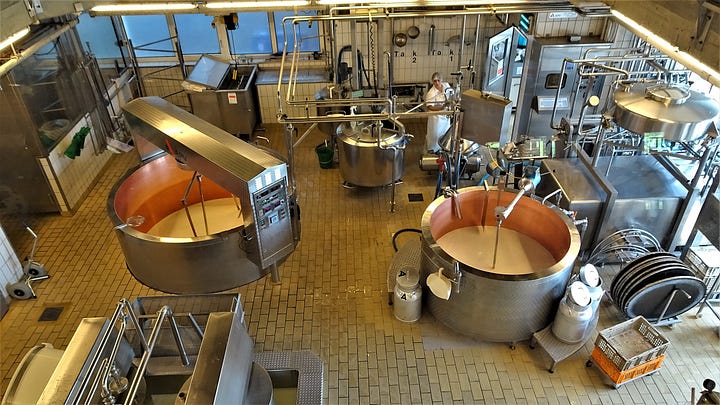Swiss cheese, the one with the holes in it
We produce a lot of cheeses, but only one Emmentaler
The Swiss Federal Administrative Court (Bundesverwaltungsgericht, truly a mouthful) is the largest of Switzerland’s four federal courts. It has the thorny task of considering the legality of rulings made by federal authorities and agencies, so covers everything from asylum and immigration law to data protection, customs law, intellectual property, labor law, social security. Also, cheese. This week, the court published a 17-page judgment regarding the holes in Switzerland’s most famous cheese export.

The Emmental cheese is a cow’s milk cheese that originated in the Emme valley, a picturesque landscape of lush rolling hills and happy cows near the capital, Bern. Like many areas in Switzerland, time seems to stand still in the Emmental. This is the land of geranium-adorned wooden farmhouses and rosy-cheeked milkmaids, where the grass is always green, the snowcapped Alps glisten in the background, and no one is lactose intolerant.
From this idyllic corner of the world comes the cheese that many know simply as “Swiss Cheese.” The one with the holes. A medium-hard, savory yet mild cheese that melts fairly well. The Emmentaler cheese is registered in Switzerland as an appellation d’origine protégée (AOP), which defines where and how the cheese can be produced and still be called a certified Emmentaler; in the EU, Emmentaler is also a legally-recognized term (protected geographical indication, or PGI). Emmental-style cheeses are produced around the world, with some like the Norwegian Jarlsberg or the Dutch Leerdammer beloved under their own names. Keeping things clear as ever, the USDA1 actually uses the terms “Swiss Cheese” and “Emmentaler” interchangeably.
How did a cheese become the subject of a philosophical court battle? Here is where the modern world encroaches on the traditional environment of cheesemaking. Whether AOP, PGI, or artisanal, cheese is now made in a highly sterile environment.


Over the past 20 years, the characteristic holes (technical jargon: “eyes”) in the Emmentaler have been disappearing. Since the introduction of modern milking machinery, fewer airborne hay particles land in the milk. And it’s those microscopic bits of hay that are responsible for the formation of holes as the fermentation process turns milk into cheese. Simply put, the milk has become too clean.
The formation of the “eyes” is a phenomenon that has been carefully studied and catalogued. This is Switzerland, after all. Article 5 of the Emmental specifications stipulates that the “organoleptic property” of the cheese should be “a regular, clean, round to slightly oval hole, mostly 2 to 4 cm in size.” Even the tradition of cheesemakers thumping the wheel of cheese to determine its ripeness has a scientific basis, as acoustical research has revealed.
The cheesemakers of the Emme valley have their own professional association, a combination marketing and lobbying group, that raised the alarm about changes in the iconic2 cheese. Is an Emmentaler without holes even an Emmentaler?
To retain the traditional appearance of the Swissiest cheese, Emmentaler Switzerland recommended its producers use a “hole-inducing powder” made from hay flowers. This natural additive has been in use in Germany (Allgäuer Emmentaler) and France (Emmental de Savoie) for some time. However, the Federal Office for Agriculture cried “nein! non!” and accused the cheese producers of deviation from tradition and (horrors!) industrialization.
The exasperated Emmentaler producers filed their complaint with the Federal Administrative Court in December 2023, and a year and a half later the court has now ruled in favor of the hay flower powder.
Sensibly, the court recognized that cheesemaking is still a natural process. The artificial contamination of the milk with hay flower powder merely creates the conditions for hole formation, without standardizing the product.
No word yet on whether the Federal Office of Agriculture plans to appeal to the Federal Supreme Court, the highest and final instance in the country. But I rather doubt it.
Or at least, they did. Frankly, I do not know if the United States Department of Agriculture still exists this week.
An overused word, but in this case absolutely correct.







Food law is fascinating. You can probably find other examples, from the serious to the silly. Austria has retained the right to label certain foods with its own dialect words, which means sometimes our ingredients lists have three different terms for the same thing (standard German plus Swiss German too (such as Obers/Sahne/Rahm). Cheese must get pretty tricky though, especially with France next door! That was quite enlightening about the holes. Who'd have ever thought of the cause?
Fascinating, both with regard to the cheese-making and the interests of the governing authorities !